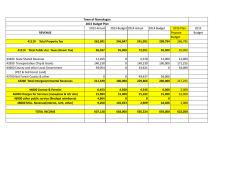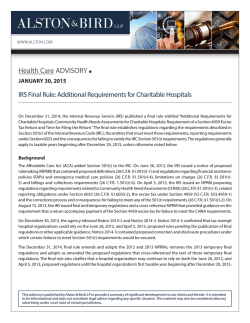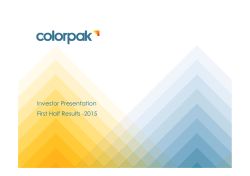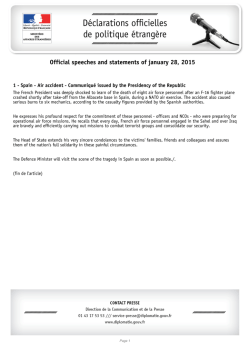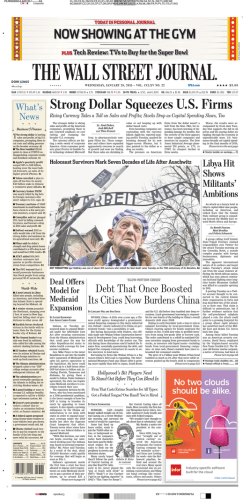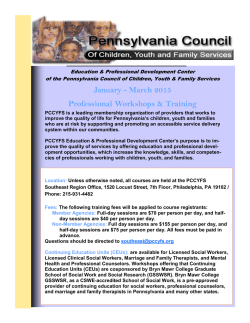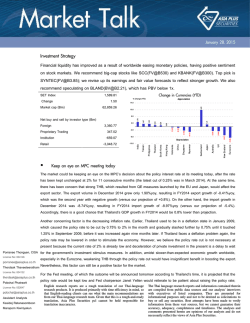
2014 Form 990 (Schedule H)
2014 Form 990, Schedule H (released December 24, 2014) OMB No. 1545-0047 Significant changes include new questions and modifications in Hospitals Section B to bring Schedule H closer in line with the section a Complete the organization answered “Yes” to Form 990, Part IV, 501(r)ifregulations (e.g., timing for new organizations toquestion conduct20. a Attach to Form 990. Open to Public CHNAs, methods for applying for financial assistance and Department of the Treasury a Information about Schedule H (Form 990) and its instructions is at www.irs.gov/form990. Inspection Internal Revenue Service widely publicizing FAP, application, and plain language Name of the organization Employer identification number summary). Additional changes include clarifications regarding group return and facility group reporting in Section B. Part I Financial Assistance and Certain Other Community Benefits at Cost SCHEDULE H (Form 990) 2014 Yes 1a Did the organization have a financial assistance policy during the tax year? If “No,” skip to question 6a . . b If “Yes,” was it a written policy? . . . . . . . . . . . . . . . . . . . . . . . . . . . . 2 If the organization had multiple hospital facilities, indicate which of the following best describes application of the financial assistance policy to its various hospital facilities during the tax year. No 1a 1b Applied uniformly to most hospital facilities Applied uniformly to all hospital facilities Generally tailored to individual hospital facilities Answer the following based on the financial assistance eligibility criteria that applied to the largest number of the organization’s patients during the tax year. 3 a Did the organization use Federal Poverty Guidelines (FPG) as a factor in determining eligibility for providing free care? If “Yes,” indicate which of the following was the FPG family income limit for eligibility for free care: 100% 150% 200% Other % b Did the organization use FPG as a factor in determining eligibility for providingdeleted "income discounted care?based" If “Yes,” indicate which of the following was the family income limit for eligibility for discounted care: . . . . . 200% 250% 300% 350% 400% Other % c If the organization used factors other than FPG in determining eligibility, describe in Part VI the criteria used for determining eligibility for free or discounted care. Include in the description whether the organization used an asset test or other threshold, regardless of income, as a factor in determining eligibility for free or discounted care. 3a 3b 4 Did the organization’s financial assistance policy that applied to the largest number of its patients during the tax year provide for free or discounted care to the “medically indigent”? . . . . . . . . . . . . 5a Did the organization budget amounts for free or discounted care provided under its financial assistance policy during the tax year? b If “Yes,” did the organization’s financial assistance expenses exceed the budgeted amount? . . . . . c If “Yes” to line 5b, as a result of budget considerations, was the organization unable to provide free or discounted care to a patient who was eligible for free or discounted care? . . . . . . . . . . . 6a Did the organization prepare a community benefit report during the tax year? . . . . . . . . . . b If “Yes,” did the organization make it available to the public? . . . . . . . . . . . . . . . . Complete the following table using the worksheets provided in the Schedule H instructions. Do not submit these worksheets with the Schedule H. 7 Financial Assistance and Certain Other Community Benefits at Cost (a) Number of (b) Persons (c) Total community (d) Direct offsetting (e) Net community Financial Assistance and activities or served benefit expense revenue benefit expense Means-Tested Government Programs programs (optional) (optional) a 4 5a 5b 5c 6a 6b (f) Percent of total expense Financial Assistance at cost (from Worksheet 1) . . . . . . Medicaid (from Worksheet 3, column a) b c Costs of other means-tested government programs (from Worksheet 3, column b) . . . . d Total Financial Assistance and Means-Tested Government Programs Other Benefits e Community health improvement services and community benefit operations (from Worksheet 4) . . f Health professions education (from Worksheet 5) . . . . g Subsidized health services (from h i j k Worksheet 6) . . . . . Research (from Worksheet 7) Cash and in-kind contributions for community benefit (from Worksheet 8) . . . . . Total. Other Benefits . . . Total. Add lines 7d and 7j . . . . . . For Paperwork Reduction Act Notice, see the Instructions for Form 990. Cat. No. 50192T Schedule H (Form 990) 2014 Page 2 Schedule H (Form 990) 2014 Part II Community Building Activities Complete this table if the organization conducted any community building activities during the tax year, and describe in Part VI how its community building activities promoted the health of the communities it serves. (a) Number of activities or programs (optional) 1 2 3 4 5 Physical improvements and housing Economic development Community support Environmental improvements Leadership development and training for community members 6 7 8 9 10 Coalition building Community health improvement advocacy Workforce development Other Total Part III (b) Persons served (optional) (c) Total community building expense (d) Direct offsetting revenue (e) Net community building expense (f) Percent of total expense Bad Debt, Medicare, & Collection Practices Section A. Bad Debt Expense 1 Did the organization report bad debt expense in accordance with Healthcare Financial Management Association Statement No. 15? Enter the amount of the organization’s bad debt expense. Explain in Part VI the 2 methodology used by the organization to estimate this amount . . . . . . . . . 2 3 Enter the estimated amount of the organization’s bad debt expense attributable to patients eligible under the organization’s financial assistance policy. Explain in Part VI the methodology used by the organization to estimate this amount and the rationale, if any, for including this portion of bad debt as community benefit. . . . . . . . . . . 3 4 Provide in Part VI the text of the footnote to the organization’s financial statements that describes bad debt expense or the page number on which this footnote is contained in the attached financial statements. Yes No 1 Section B. Medicare 5 Enter total revenue received from Medicare (including DSH and IME) . . . . . . . 5 6 Enter Medicare allowable costs of care relating to payments on line 5 . . . . . . . 6 7 Subtract line 6 from line 5. This is the surplus (or shortfall) . . . . . . . . . . . 7 8 Describe in Part VI the extent to which any shortfall reported in line 7 should be treated as community benefit. Also describe in Part VI the costing methodology or source used to determine the amount reported on line 6. Check the box that describes the method used: Cost accounting system Cost to charge ratio Other Section C. Collection Practices 9a Did the organization have a written debt collection policy during the tax year? . . . . . . . . . . b If “Yes,” did the organization’s collection policy that applied to the largest number of its patients during the tax year contain provisions on the collection practices to be followed for patients who are known to qualify for financial assistance? Describe in Part VI . . . Part IV 9a 9b Management Companies and Joint Ventures (owned 10% or more by officers, directors, trustees, key employees, and physicians—see instructions) (a) Name of entity (b) Description of primary activity of entity (c) Organization’s (d) Officers, directors, trustees, or key profit % or stock employees’ profit % ownership % or stock ownership % (e) Physicians’ profit % or stock ownership % 1 2 3 4 5 6 7 8 9 10 11 12 13 Schedule H (Form 990) 2014 Page 3 Schedule H (Form 990) 2014 Part V Facility Information ER–other ER–24 hours Research facility Critical access hospital 2 Teaching hospital 1 Children’s hospital Name, address, primary website address, and state license number (and if a group return, the name and EIN of the subordinate hospital organization that operates the hospital facility) General medical & surgical How many hospital facilities did the organization operate during the tax year? Licensed hospital Section A. Hospital Facilities (list in order of size, from largest to smallest—see instructions) Facility reporting group Other (describe) Adds requirement that group returns must provide the name and EIN of the subordinate operating the hospital facility 3 4 5 6 7 8 9 10 Schedule H (Form 990) 2014 Page 4 Schedule H (Form 990) 2014 Part V Facility Information (continued) Section B. Facility Policies and Practices Clarifies that facility reporting groups should list letter from Part V, Section A (Complete a separate Section B for each of the hospital facilities or facility reporting groups listed in Part V, Section A) Name of hospital facility or letter of facility reporting group Line number of hospital facility, or line numbers of hospital facilities in a facility reporting group (from Part V, Section A): Indicates line number from 2013 Schedule H Yes No Community Health Needs Assessment 1 Was the hospital facility first licensed, registered, or similarly recognized by a State as a hospital facility in the current tax year or the immediately preceding tax year?. . . . . . . . . . . . . . . . . . 1 2 Was the hospital facility acquired or placed into service as a tax-exempt hospital in the current tax year or the immediately preceding tax year? If “Yes,” provide details of the acquisition in Section C . . . . . . 2 3 During the tax year or either of the two immediately preceding tax years, did the hospital facility conduct a 1 community health needs assessment (CHNA)? If “No,” skip to line 12 . . . . . . . . .New . Lines . . .1 & 2 3help to If “Yes,” indicate what the CHNA report describes (check all that apply): determine when CHNA first a A definition of the community served by the hospital facility required for new facilities b Demographics of the community Existing health care facilities and resources within the community that are available to respond to the c Previously, skipped to FAP health needs of the community questions, now directed to d How data was obtained question about excise tax under e The significant health needs of the community 4959 f Primary and chronic disease needs and other health issues of uninsured persons, low-income persons, and minority groups g The process for identifying and prioritizing community health needs and services to meet the community health needs h The process for consulting with persons representing the community's interests i Information gaps that limit the hospital facility's ability to assess the community's health needs j Other (describe in Section C) 2 4 Indicate the tax year the hospital facility last conducted a CHNA: 20 3 5 In conducting its most recent CHNA, did the hospital facility take into account input from persons who represent the broad interests of the community served by the hospital facility, including those with special knowledge of or expertise in public health? If “Yes,” describe in Section C how the hospital facility took into account input from persons who represent the community, and identify the persons the hospital facility consulted . . . . . . 5 4 6 a Was the hospital facility's CHNA conducted with one or more other hospital facilities? If "Yes," list the other hospital facilities in Section C . . . . . . . . . . . . . . . . . . . . . . . . . . b Was the hospital facility's CHNA conducted with one or more organizations other than hospital facilities? If “Yes,” list the other organizations in Section C . . . . . . . . . . . . . . . . . . . . . . . 7 Did the hospital facility make its CHNA report widely available to the public? . . . . . . . . . . 5 If “Yes,” indicate how the CHNA report was made widely available (check all that apply): a Hospital facility's website (list url): b Other website (list url): c Made a paper copy available for public inspection without charge at the hospital facility Changed from "available upon request" Other (describe in Section C) d 8 Did the hospital facility adopt an implementation strategy to meet the significant community health needs identified through its most recently conducted CHNA? If “No,” skip to line 11 . . . . . . . . . . 9 10 Indicate the tax year the hospital facility last adopted an implementation strategy: 20 Is the hospital facility's most recently adopted implementation strategy posted on a website? . . . . . a If “Yes,” (list url): b If “No,” is the hospital facility's most recently adopted implementation strategy attached to this return? . . 7 11 Describe in Section C how the hospital facility is addressing the significant needs identified in its most recently conducted CHNA and any such needs that are not being addressed together with the reasons why such needs are not being addressed. 6a 6b 7 8 10 10b 8 12 a Did the organization incur an excise tax under section 4959 for the hospital facility's failure to conduct a CHNA as required by section 501(r)(3)? . . . . . . . . . . . . . . . . . . . . . . . b If “Yes” to line 12a, did the organization file Form 4720 to report the section 4959 excise tax? . . . . . c If “Yes” to line 12b, what is the total amount of section 4959 excise tax the organization reported on Form 4720 for all of its hospital facilities? $ Previously, required only a "Yes" response if addressed all needs 12a 12b Schedule H (Form 990) 2014 Page 5 Schedule H (Form 990) 2014 Part V Facility Information (continued) Financial Assistance Policy (FAP) Header on each page of Part V, Section B Name of hospital facility or letter of facility reporting group Yes 9 13 10-11 a b c d e f g h 12 14 13 15 a b c d e 14 16 a b c d e f g h No Did the hospital facility have in place during the tax year a written financial assistance policy that: 13 Explained eligibility criteria for financial assistance, and whether such assistance included free or discounted care? If “Yes,” indicate the eligibility criteria explained in the FAP: Line 13a Federal poverty guidelines (FPG), with FPG family income limit for eligibility for free care of % combines 2013 Lines 10 and 11 and FPG family income limit for eligibility for discounted care of % Income level other than FPG (describe in Section C) Asset level Lines 13b-h include factors Medical indigency previously identified as basis Insurance status for amounts charged to Underinsurance status patients (2013 Line 12) Changed from Residency "uninsured discount" Other (describe in Section C) 14 Explained the basis for calculating amounts charged to patients? Factors . . . modified . . . and . . moved . . .to .Line . 13 . Explained the method for applying for financial assistance? . . . . . . . . . . . . . . . . 15 If “Yes,” indicate how the hospital facility's FAP or FAP application form (including accompanying Line 15 instructions) explained the method for applying for financial assistance (check all that apply): requests how Described the information the hospital facility may require an individual to provide as part of his or her FAP explained application method for Described the supporting documentation the hospital facility may require an individual to submit as part applying for of his or her application assistance Provided the contact information of hospital facility staff who can provide an individual with information about the FAP and FAP application process Provided the contact information of nonprofit organizations or government agencies that may be sources of assistance with FAP applications Other (describe in Section C) Included measures to publicize the policy within the community served by the hospital facility? . . . . If “Yes,” indicate how the hospital facility publicized the policy (check all that apply): The FAP was widely available on a website (list url): The FAP application form was widely available on a website (list url): A plain language summary of the FAP was widely available on a website (list url): The FAP was available upon request and without charge (in public locations in the hospital facility and by mail) The FAP application form was available upon request and without charge (in public locations in the hospital facility and by mail) A plain language summary of the FAP was available upon request and without charge (in public locations in the hospital facility and by mail) 16 Line 16 expands publicizing FAP methods; delete "billing & invoice attachments" and "providing on admission" as options Notice of availability of the FAP was conspicuously displayed throughout the hospital facility Notified members of the community who are most likely to require financial assistance about availability of the FAP i Other (describe in Section C) Billing and Collections 15 17 Did the hospital facility have in place during the tax year a separate billing and collections policy, or a written financial assistance policy (FAP) that explained all of the actions the hospital facility or other authorized party may take upon non-payment? . . . . . . . . . . . . . . . . . . . . . . . . . . 17 Check all of the following actions against an individual that were permitted under the hospital facility's policies during the tax year before making reasonable efforts to determine the individual's eligibility under the facility's FAP: Changes items to more closely track 16 18 a b c d e Reporting to credit agency(ies) (ies) Selling an individual's debt to another party Actions that require a legal or judicial process Other similar actions (describe in Section C) None of these actions or other similar actions were permitted regulations: deletes liens and body attachments; modifies "lawsuits" to actions requiring legal or judicial process Schedule H (Form 990) 2014 Page 6 Schedule H (Form 990) 2014 Part V Facility Information (continued) Name of hospital facility or letter of facility reporting group Yes 17 19 No Did the hospital facility or other authorized party perform any of the following actions during the tax year before making reasonable efforts to determine the individual's eligibility under the facility's FAP? . . . . a b c d 18 20 a b c d 19 If “Yes,” check all actions in which the hospital facility or a third party engaged: Changes items to more closely track regulations: deletes liens and body Reporting to credit agency(ies) (ies) attachments; modifies "lawsuits" to actions Selling an individual's debt to another party requiring legal or judicial process; adds Actions that require a legal or judicial process selling debt to third party Other similar actions (describe in Section C) Indicate which efforts the hospital facility or other authorized party made before initiating any of the actions listed (whether or not checked) in line 19 (check all that apply): Notified individuals of the financial assistance policy on admission Notified individuals of the financial assistance policy prior to discharge Notified individuals of the financial assistance policy in communications with the individuals regarding the individuals' bills Documented its determination of whether individuals were eligible for financial assistance under the hospital facility's financial assistance policy e Other (describe in Section C) f None of these efforts were made Policy Relating to Emergency Medical Care 19 21 Did the hospital facility have in place during the tax year a written policy relating to emergency medical care that required the hospital facility to provide, without discrimination, care for emergency medical conditions to individuals regardless of their eligibility under the hospital facility's financial assistance policy? . . . . 21 If “No,” indicate why: a The hospital facility did not provide care for any emergency medical conditions The hospital facility's policy was not in writing b The hospital facility limited who was eligible to receive care for emergency medical conditions (describe c in Section C) d Other (describe in Section C) Charges to Individuals Eligible for Assistance Under the FAP (FAP-Eligible Individuals) 20 22 Indicate how the hospital facility determined, during the tax year, the maximum amounts that can be charged to FAP-eligible individuals for emergency or other medically necessary care. The hospital facility used its lowest negotiated commercial insurance rate when calculating the a maximum amounts that can be charged The hospital facility used the average of its three lowest negotiated commercial insurance rates when b calculating the maximum amounts that can be charged The hospital facility used the Medicare rates when calculating the maximum amounts that can be c charged d 21 23 22 24 Other (describe in Section C) During the tax year, did the hospital facility charge any FAP-eligible individual to whom the hospital facility provided emergency or other medically necessary services more than the amounts generally billed to individuals who had insurance covering such care? . . . . . . . . . . . . . . . . . . . If “Yes,” explain in Section C. During the tax year, did the hospital facility charge any FAP-eligible individual an amount equal to the gross charge for any service provided to that individual? . . . . . . . . . . . . . . . . . . . If “Yes,” explain in Section C. 23 24 Schedule H (Form 990) 2014 Page 7 Schedule H (Form 990) 2014 Part V Facility Information (continued) Section C. Supplemental pp Information for Part V,, Section B. Provide descriptions p required for Part V, Section B, lines provide separate 2, 3j, 5, 6a, 6b, 7d, 11, 13b, 13h, 15e, 16i, 18d, 19d, 20e, 21c, 21d, 22d, 23, and 24. If applicable, pp p p p p p g group, g p designated g p g group g p letter and descriptions for each hospital facilityy in a facilityy reporting byy facilityy reporting hospital facility line number from Part V, Section A (“A, 1,” “A, 4,” “B, 2,” “B, 3,” etc.) and name of hospital facility. Line numbers changed to reflect new questions; adds reporting for Lines 2, 6b, 13b, and 15e Supplemental information provided for facility reporting groups must be designated by letter, line number, and name of facility Schedule H (Form 990) 2014 Page 8 Schedule H (Form 990) 2014 Part V Facility Information (continued) Section D. Other Health Care Facilities That Are Not Licensed, Registered, or Similarly Recognized as a Hospital Facility (list in order of size, from largest to smallest) How many non-hospital health care facilities did the organization operate during the tax year? Name and address Type of Facility (describe) 1 2 3 4 5 6 7 8 9 10 Schedule H (Form 990) 2014 Page 9 Schedule H (Form 990) 2014 Part VI Supplemental Information Provide the following information. 1 2 3 4 5 6 7 Required descriptions. Provide the descriptions required for Part I, lines 3c, 6a, and 7; Part II and Part III, lines 2, 3, 4, 8 and 9b. Needs assessment. Describe how the organization assesses the health care needs of the communities it serves, in addition to any CHNAs reported in Part V, Section B. Patient education of eligibility for assistance. Describe how the organization informs and educates patients and persons who may be billed for patient care about their eligibility for assistance under federal, state, or local government programs or under the organization’s financial assistance policy. Community information. Describe the community the organization serves, taking into account the geographic area and demographic constituents it serves. Promotion of community health. Provide any other information important to describing how the organization’s hospital facilities or other health care facilities further its exempt purpose by promoting the health of the community (e.g., open medical staff, community board, use of surplus funds, etc.). Affiliated health care system. If the organization is part of an affiliated health care system, describe the respective roles of the organization and its affiliates in promoting the health of the communities served. State filing of community benefit report. If applicable, identify all states with which the organization, or a related organization, files a community benefit report. Schedule H (Form 990) 2014 Annotations as of 1/30/2015
© Copyright 2025
